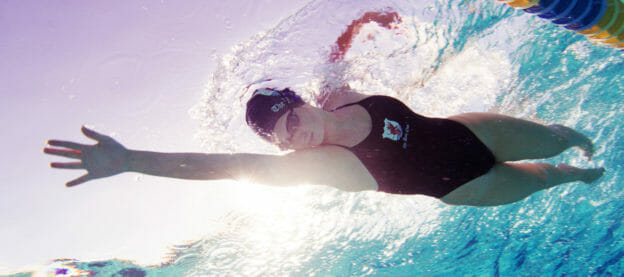Sprint Freestyle Pulling Motion: Deep or Deeper?
I have often noticed, particularly among young female sprinters, that the pulling motion used in a sprint is the same technique they utilize in their distance freestyle swims: high elbow, low drag. While this pulling technique may be commendable for any freestyle event over 100 meters, it is not the pulling technique used by elite sprinters, male or female.
Instead, the pulling motion of the elite sprinter tends to be deeper, ranging from a small bend in the elbow to nearly a deep, straight arm pulling motion. Since the majority of the propulsion occurs at the swimmer’s hands (not the forearm), pulling the deeper hand through the water at the same speed as when the hand is closer to the shoulder requires more propulsion load (muscle).
The deeper pulling motion of the sprinter changes the biomechanics of the pull, engaging more of the stronger muscles, like the latissimus dorsi and the pectoralis major and minor muscles. It is very possible that young swimmers simply haven’t developed the strength required to pull the deeper hand through the water fast enough. Therefore, they are forced to use the higher elbow pulling motion, or let their hands slip through the water.
When teaching young swimmers to sprint, we must be careful to recommend the technique that works the best for them. A deeper pulling motion will result in more torque on the shoulder and can put the young swimmer at greater risk of shoulder injury, particularly in a longer swimming event.
When teaching older, stronger swimmers sprint technique, who may have the strength to pull correctly, I have found that they may not use the proper technique to hold onto the water with the pulling hands. I have seen far too many strong swimmers who may achieve high stroke rates, yet allow the hand to turn outward, inward, or slide upward, losing a significant grip on the water.
Last week, when we analyzed Brad Tandy’s sprint technique, we found that when he tried to increase his stroke rate significantly, he lost propulsion with his right hand, resulting in a slower swimming speed. This week, you will discover what happens when he bends his elbows more on the pulling arms.
In the end, when determining the right pulling motion for your sprint freestyle technique, it may depend on your age, your level of strength and how well you hold onto the water using each technique. Sometimes you simply need to change things up a bit to see which technique works best for you.
Yours in Swimming,
Gary Sr.

